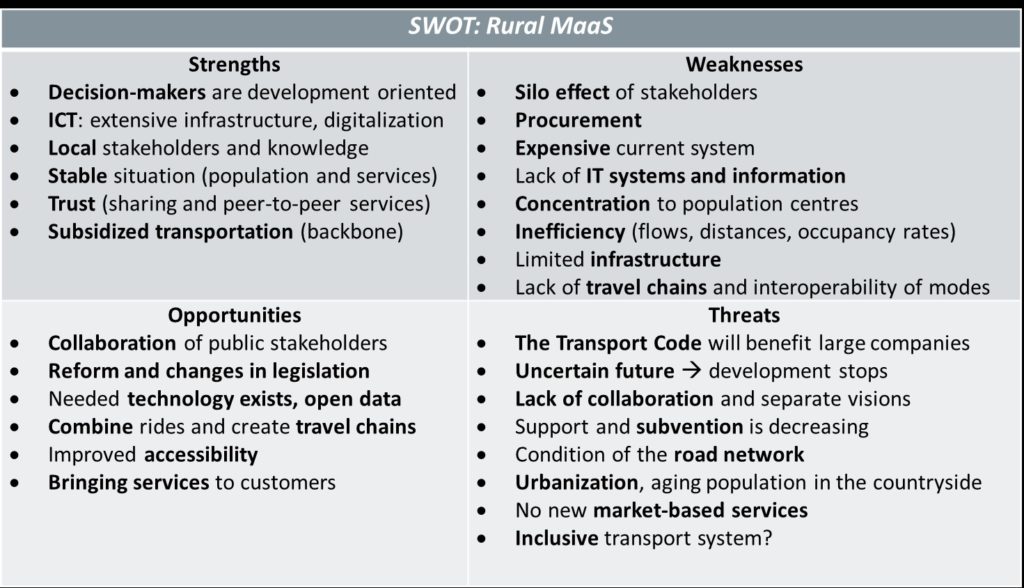VTT Technical Research Centre of Finland Ltd. has studied Mobility as a Service (MaaS) concept in rural areas. The results indicate that the collaboration of relevant stakeholders is the key enabler of rural MaaS. Combining different transport services and creating travel chains are identified as opportunities for rural areas.
Project
The project ‘Mobility as a Service Concept Promoting Service and Livelihood Development in Rural Areas’ (Rural-MaaS) was co-funded by the development fund of the Ministry of Agriculture and Forestry of Finland and was conducted in 2016–2017. The project studied business, regulation and technology aspects and proposed e.g. rural MaaS SWOT, vision and measures. The Rural-MaaS was based on qualitative data collected via regional and national workshops, 30 interviews and a literature review.

Mobility as a Service, MaaS, on rural roads in Finland has been studied by VTT. Photo: Elena Noeva/Mostphotos
Rural mobility vision, SWOT and measures
The Rural-MaaS project defined the rural mobility vision as: “Ensure for everyone adequate mobility services and accessibility relative to well-being, cost-efficiently with an appropriate service level”. Other aspects of the vision include maintaining the vitality of rural areas and offering reasonably priced services to everyone regardless of their place of residence, as mobility is a prerequisite e.g. for healthcare, business and accessibility.
The current state of rural mobility was analysed using SWOT (Table 1). The strengths include the consensus among decision-makers on the need for development. In addition, highly developed and extensive ICT infrastructure and digitalization are recognized as strengths. Subsidized transportation serves as a backbone in rural areas that new transport solutions could potentially be integrated into. In general, people in rural areas usually know and trust their neighbors more than those in cities do, facilitating e.g. peer-to-peer services.
The main weaknesses include the silo effect within and between organizations. The operational environment of rural mobility is challenging due to low and sparse population, and long distances between people and services. Lack of competence and resources may lead to disadvantageous public procurement.

Table 1. Rural MaaS SWOT (modified and translated from Eckhardt et al., 2017)
The main opportunities are related to collaboration, and combining of different services and creating travel chains. Services could also be brought to users virtually or physically (e.g. library bus) reducing mobility needs.
The main threats are related to uncertainties due to current changes and reforms (the Transport Code and potential social services and regional government reform) and the lack of financial resources. The operational environment of rural mobility services will become increasingly challenging due to urbanization, as well as decreasing and aging population. Furthermore, the accessibility of special groups is a concern.
The main measures of future rural mobility include:
- Combining different publicly subsidized transportation to increase efficiency. These include hospital districts transportation (between hospitals and other health centers), sickness related subsidized transportation and transportation organized by municipalities including e.g. school transportation and social and health service transportation (e.g. the elderly, disabled).
- Organizing mobility services on a one-stop-shop principle including subsidized and commercial services, as well as shared resources (e.g. ride-sharing).
- Increasing the use of new mobility services, such as ride-sharing, demand-responsive transport, travel chains, and autonomous driving in the future.
Next steps with MaaS in rural areas
More MaaS pilots in rural areas are needed to identify and disseminate best practices. For example, in the ongoing Finnish Innovation Fund Sitra funded project rural MaaS pilots are included. The Tampere region pilot combines demand-responsive service transport (minibus), subsidized taxi services for health and social service clients and self-paying customers using a smartphone application in the same system. This is expected to increase efficiency, bring about cost savings to public sector and increase accessibility.
More information on rural MaaS:
- Eckhardt, J., Nykänen, L., Aapaoja, A. & Niemi, P. (2017) Liikkumispalvelut maaseudun elinvoimaisuuden ja saavutettavuuden mahdollistajana [Mobility as a Service as an enabler for vitality and accessibility of rural areas] (in Finnish). VTT research report VTT-R-03429-17.
- Eckhardt, J., Nykänen, L., Aapaoja, A. & Niemi, P. (2018). MaaS in rural areas – case Finland. Research in Transportation Business & Management, 27, 75–83.
- Public and private mobility services to be offered side by side.
 Contact:
Contact:
Jenni Eckhardt
jenni.eckhardt@vtt.fi
VTT, Technical Research Centre of Finland, Finland






Follow us: